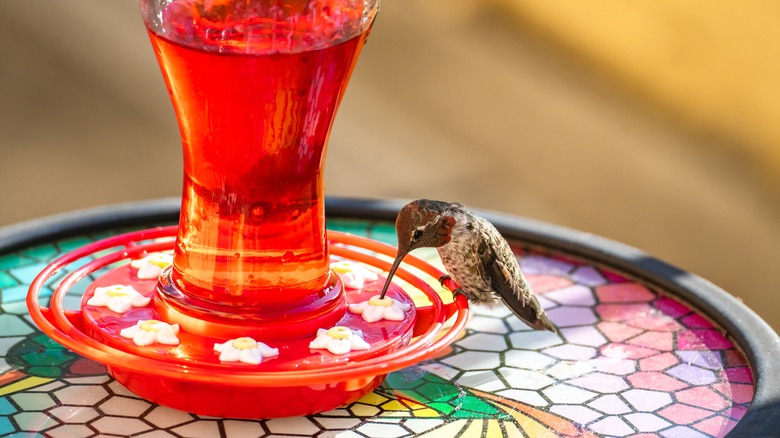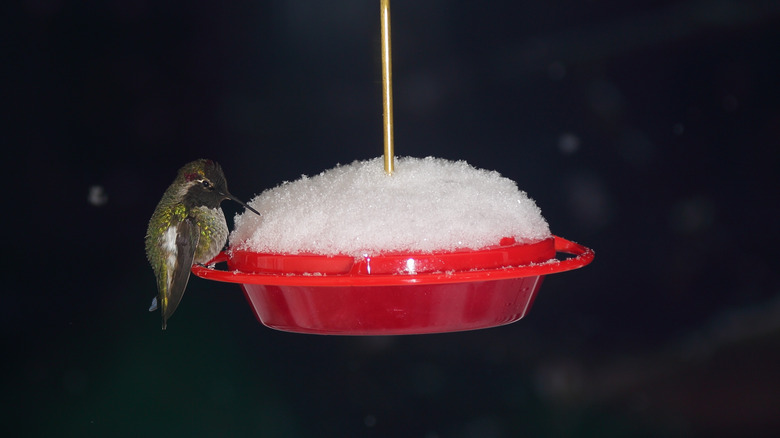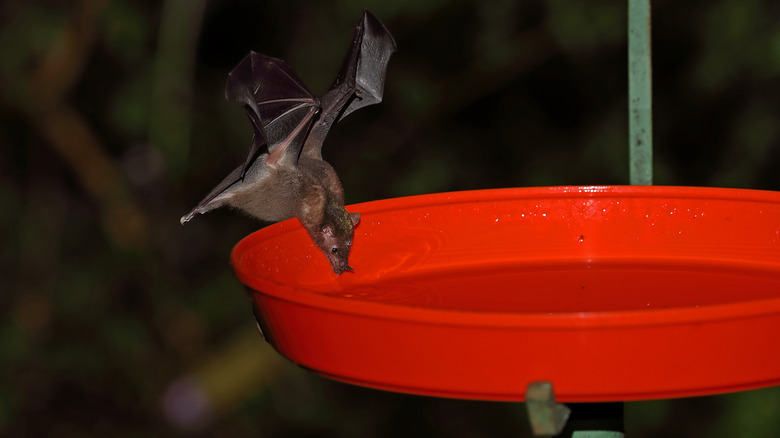Do Hummingbird Feeders Need To Be Brought Indoors At Night?
Hummingbirds are fascinating creatures that can brighten any space with their vibrant plumage and flappy wings. So, it's no wonder that homeowners hang bird feeders filled with sugary syrup mimicking flower nectar to attract them to their backyard and enjoy their mesmerizing aerial displays up close. While it is commonly known that hummingbirds are diurnal, meaning that they mostly feed during the day, bird enthusiasts often wonder whether this is reason enough to bring their feeders inside at night. While the answer hinges on several factors including regional climate, the natural behaviors of birds, local wildlife, and the type of hummingbird feeder you own, most of the time, it's a good idea to bring them indoors when the sun sets.
Even though most feeders can survive weather changes, the sugar solution may not. Extreme weather conditions can adversely impact the nectar, causing it to spoil rapidly in hot temperatures and freeze during frost conditions, necessitating moving the feeder indoors. Also consider taking the feeding station inside if your landscape is surrounded by nocturnal animals, especially squirrels and raccoons, who would love that sweet stuff.
Climate and weather considerations
In milder climates, leaving feeders outside at night is a non-issue since many hummingbirds venture out during the early hours before dawn to snack on nectar. Moreover, with plenty of homes lit up with yard lights, some hummingbirds may be enticed to feed even at night. However, if the temperatures continue to stay high at night, it is ideal to bring the feeder inside to prevent the nectar from spoiling. Keeping it indoors also becomes necessary during bad weather conditions like heavy rainfall and gusty winds so it doesn't get knocked over or become damaged.
Additionally, in regions experiencing harsh winters, especially frost, bringing feeders inside and putting them back early in the morning is the right call. Otherwise, the overwintering backyard birds need to wait for hours for the sugar solution to thaw. Moreover, frozen nectar — it usually starts hardening once the temperature drops lower than 27 degrees Fahrenheit — can damage the feeding station, lowering its utility. On the other hand, if your area only has migratory birds, you can safely move the bird station inside until spring arrives.
Other factors to consider
Another factor that comes into play when deciding whether the hummingbird feeder should be kept outside or brought inside is the presence of nocturnal visitors. Squirrels, bears, bats, and raccoons are often found rummaging through the feeder for its sugary nectar to satiate their appetites. Consequently, they may damage the feeding station during their hunt. Feeders with big holes may even become the hunting ground for orioles and finches. To prevent these unwelcome guests from stealing the sweet solution, bringing the hummingbird feeder inside at night is ideal.
Additionally, consider the material of the feeder. While glass feeders are generally considered more durable than plastic, they might get damaged during bad weather. Moreover, hummingbird feeders need to be cleaned regularly — at least twice a week during the summer and once a week during the winter — to prevent the sugar solution from developing mold. Bringing bird stations inside at night offers the perfect opportunity to sanitize them.


